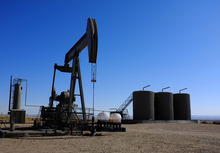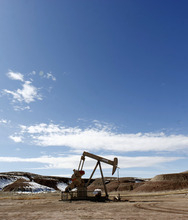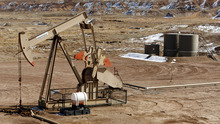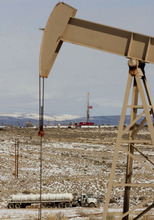This is an archived article that was published on sltrib.com in 2012, and information in the article may be outdated. It is provided only for personal research purposes and may not be reprinted.
Vernal • Times are good in the Utah oil patch.
Could they be better without federal meddling?
Record gas production and a rebounding crude output are pumping hundreds of millions of dollars into the state budget. Uintah County, the state's hydrocarbon mother lode, had just 4.2 percent unemployment in December — the state's lowest rate and half the national average. The main drag along U.S. 40 in Vernal and Naples is a hopscotch run of chain-linked oil-field service companies, which supplies workers well beyond the Beehive State, including to North Dakota's oil boom.
Utah officials predict a long, lucrative future in the business (bigger than the $4 billion that the state says flowed from the ground last year), and the government has leased far more lands and permitted more wells than industry has developed.
So why all the fuss about federal obstruction of drilling?
"They can say whatever they want," Bill Ryan, a Vernal-based oil-field services consultant, said of an Interior Department that he believes is blocking what could be a much larger industry. "[President Barack] Obama's administration can say they're pro-development, but they always add 'as long as it's environmentally sound.' They're using the environmental argument to hamper development."
While state lawmakers threaten a long-shot legal bid to own Utah's federal lands and prime the petroleum pump, the congressional delegation rails against an administration it calls anti-energy. State and county officials say the problem is with a bureaucracy that strings out permitting long enough to deter some would-be bidders.
"We're seeing more exploitation of state and private lands just because companies are seeing that it's getting more difficult on federal lands," said John Baza, director of the Utah Division of Oil, Gas and Mining.
In each of the past four years Utah's natural gas production has eclipsed 400 billion cubic feet, doubling the state's output from the mid-1980s, according to division records. Meanwhile, crude oil production, which peaked at 40 million barrels in the '80s and then crashed — marking a low of 14 million in 2004 — is back to more than 20 million despite the developed field's steady decline in the pressure that causes oil to gush.
Combined oil and gas production wells now top 10,000, an all-time high even as natural gas prices have slumped by about half since 2008. New resources likely will be developed in shales such as eastern Utah's Mancos formation, Baza said, harboring gas that could fuel a boom like the one hydraulic fracturing has enabled in the East. Utah took in $306 million from the oil and gas industry last year, which is not counting the state share of federal royalties.
Federal environmental studies for two expanded gas fields in coming months are expected to authorize more than 5,000 new wells in the state.
Still, Baza complains of federal foot-dragging. Environmental reviews delay leasing at one stage and well permitting at another, he said, often for months. He has offered state personnel to help process well permits and speed drilling, but the U.S. Bureau of Land Management has a legal oversight requirement and has declined.
"Even though we've got record numbers of wells out there," Baza said, "they could be even higher if federal impediments weren't there."
Utah Petroleum Association Executive Director Lee Peacock agreed and argued the BLM should lease more holdings.
"Leasing is the lifeblood of the oil and gas industry," Peacock said. "There are certain areas where industry would prospectively want to take a closer look that currently aren't being leased."
Many point to the 77 eastern Utah leases that Interior Secretary Ken Salazar pulled in early 2009 for further environmental review, although the government has since sold six of those.
Environmentalists look at the numbers indicating an energy boom and wonder why Washington is such a dirty word in Utah.
"Really? The 77 leases were the end of the oil and gas industry in Uintah County?" said Steve Bloch, attorney for Southern Utah Wilderness Alliance. "Most of the Uinta Basin is under lease."
—
Wells in waiting • The Checks and Balances Project, which tracks energy-policy issues, released a 2011 year-end report noting that the industry is "under-utilizing" already-available federal lands. Of 4.8 million acres leased in Utah during fiscal 2010, only 1.1 million were developed.
Companies have sought fewer acres for lease in recent years, though still at a faster rate than those parcels are sold.
The administration's environmental caution has allowed for compromises protecting resources and recreation around the White River and Nine Mile Canyon, Bloch said, while other popular recreation zones such as Desolation Canyon remain under drilling pressure. It's a switch from the Bush administration when all the West appeared open for business.
"We're so far pleased by what we've seen from the Salazar-Obama administration," Bloch said. "They're keeping up those levels of energy [development] that are an important factor in Utah's economy, but at the same time we haven't seen the level of acrimony that we saw in the last administration."
Nationwide on Sept. 30 — the latest report available — the industry had permission for 7,000 wells that it had yet to drill on BLM grounds, agency spokeswoman Megan Crandall said. More than 1,000 of those were in Utah.
"Industry has more acreage under lease than it can put to productive use," she wrote in an email. "We want to encourage diligent development of leases that have been sold but that are sitting idle, so that energy reaches the market and taxpayers can benefit from the development of their resources, as well as the creation of well-paying jobs."
It's true that there are excess permits to drill, but that's largely due to price fluctuations in the months after a company applies for permission, said Anadarko regulatory-affairs officer Brad Miller. Falling natural gas prices have made companies less willing than they originally were to gamble on drilling in unproven areas.
Nationally, there's a 5,000 well-permit backlog chugging through BLM's bureaucracy, Miller said. Staffing levels in the various state offices make a difference. Permits usually come within 180 days in Wyoming, he said, but in the Uinta Basin the average is near 300.
Uintah County Commissioner Mike McKee noted that six of the 77 disputed leases re-offered late last year sold for millions. Companies invest serious money, he said, and it leads to jobs and local revenues. But companies are now suggesting fewer areas to lease, and McKee blames that on the difficulty in well permitting.
"I've heard that the administration is beginning to open up their ideas of allowing more drilling," he said. "We'll see what happens."
The administration's repeated claims of support for domestic energy production have failed to sway Utah politicians. After Obama's State of the Union address this winter, Rep. Rob Bishop, R-Utah, questioned the president's energy agenda in the face of a canceled Canadian oil pipeline plan and the 77 revoked leases.
"The president has spent the majority of his tenure not doing what's best for hard-working Americans, or in the best interest of our nation's energy independence and security," Bishop said, "but instead what's most politically advantageous to him."
Meantime, the Utah Legislature is steering bills that would force a court clash with the U.S. government over who should control federal lands — hanging on an interpretation of the state's enabling act, which sponsors say includes a federal pledge to sell its lands. Many legal scholars — including legislative lawyers — have a different read of the act and say Congress has a clear constitutional authority to control lands.
—
Air and antelope • The industry's environmental footprint remains in question, potentially to its own detriment. Unhealthful ozone levels have plagued the basin, and the Environmental Protection Agency has warned of possible development restrictions if they persist. The exact causes are not yet defined, though gas wells are widely believed responsible, as they've been shown to be in another major gas field around Pinedale, Wyo. Last month a team of researchers began a study to determine just what's happening to the air.
On the land, pronghorn antelope numbers have slumped as gas rigs have ascended. For instance, the Nine Mile-Anthro herd in southern Duchesne, western Uintah and northern Carbon counties — a major gas zone rising from the basin to the Tavaputs Plateau — plunged from a 1998 high of 1,104 animals to 159 spotted in the 2010 aerial survey, according to a 2010 Division of Wildlife Resources report.
Rapid oil and gas development limits "forage availability and habitat effectiveness," state biologists wrote. "Habitat loss and disturbance associated with drilling and other energy extraction activities is a significant factor affecting pronghorn populations."
It wasn't the only element working against wildlife. A drought and two hard winters in that 12-year span likely took their toll, regional biologist Charles Greenwood said.
For a few conservationists living in the Uinta Basin, enough is enough. Energy development has brought jobs, of course, but also has closed in on cherished recreation zones like the White River and Desolation Canyon, which drew river guide Herm Hoops here from Vermont, first as a frequent visitor in the 1970s and then as a full-timer in 1986. That's when he bought his split-level ranch home off the dirt roads of Jensen for $35,000 — a bargain courtesy of a previous oil bust.
"I'm not sure we have to drill every last drop we have right at the minute," Hoops said, declaring that the constant rumble of trucks and shine of light cheapen the area's appeal. "It's greed."
Thoughtful development is one thing, he said, but the goal is to sink every well possible. The taxes pay for community services — officials point to a new rec center and a county library now going up in Vernal with help from energy dollars — but permanent residents will be left to support those after the next crash.
He worries about the Book Cliffs to his south, a potential target for more minerals. "People need to use a little care before they start ripping into stuff, building roads."
From his couch, Hoops has a clear view of Split Mountain, the craggy river canyon inside Dinosaur National Monument. He knows his opinions are in the minority here, but with a vista like that and world-class rapids nearby, he doesn't care, even if industry backers sometimes confront him when he testifies at land-use hearings.
"We call this our protective bubble," he said, referring to the small homestead.
On the street in Vernal, George Burnett demonstrates daily how most others feel. He's the guy in the straw cowboy hat who stands smiling huge outside his custom truck seat-covers shop waving the "Honk If You [Heart] Drilling" sign. Most honk, but a few — mainly tourists, he said — object.
"When I get that single-finger salute," he said, "I say, 'But you're driving! Don't you get it?' "
bloomis@sltrib.comtwitter: @brandonloomis —
Energy series
This story is part of a continuing Salt Lake Tribune series about Utah's energy prospects. —
Coming Monday
Dangerous ozone levels are plaguing the Uinta Basin, but who's looking out for residents?

























